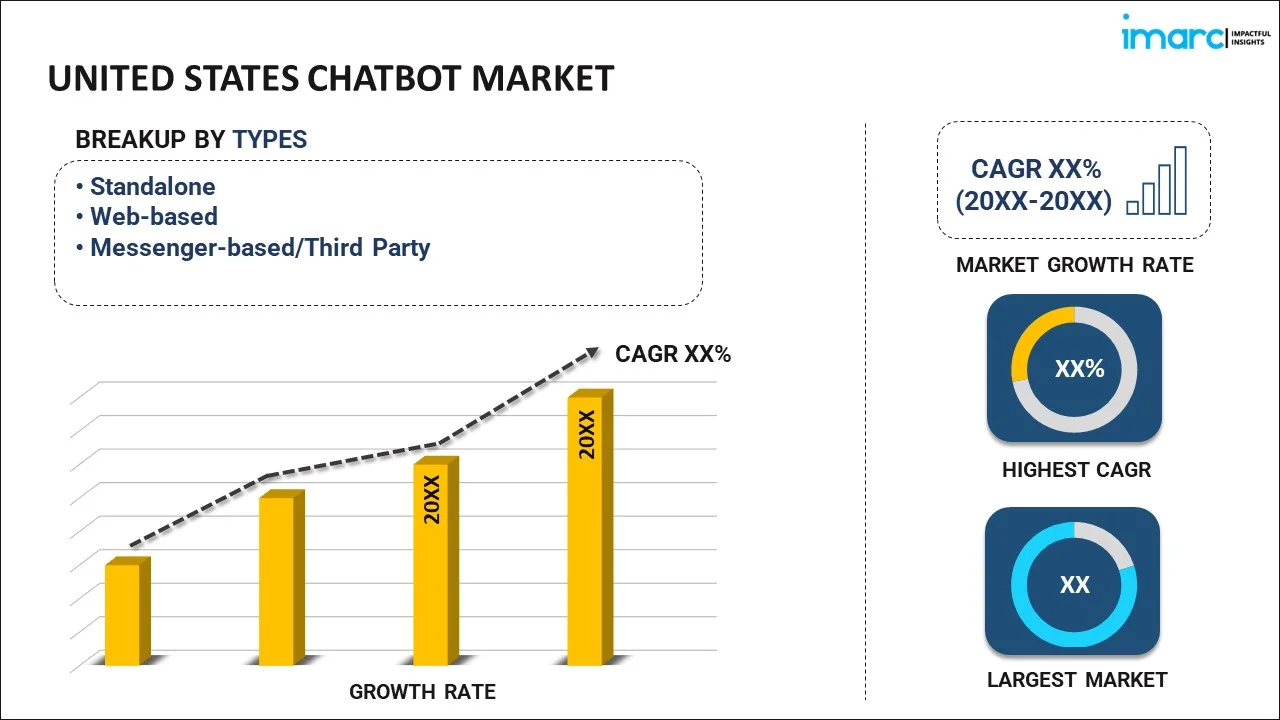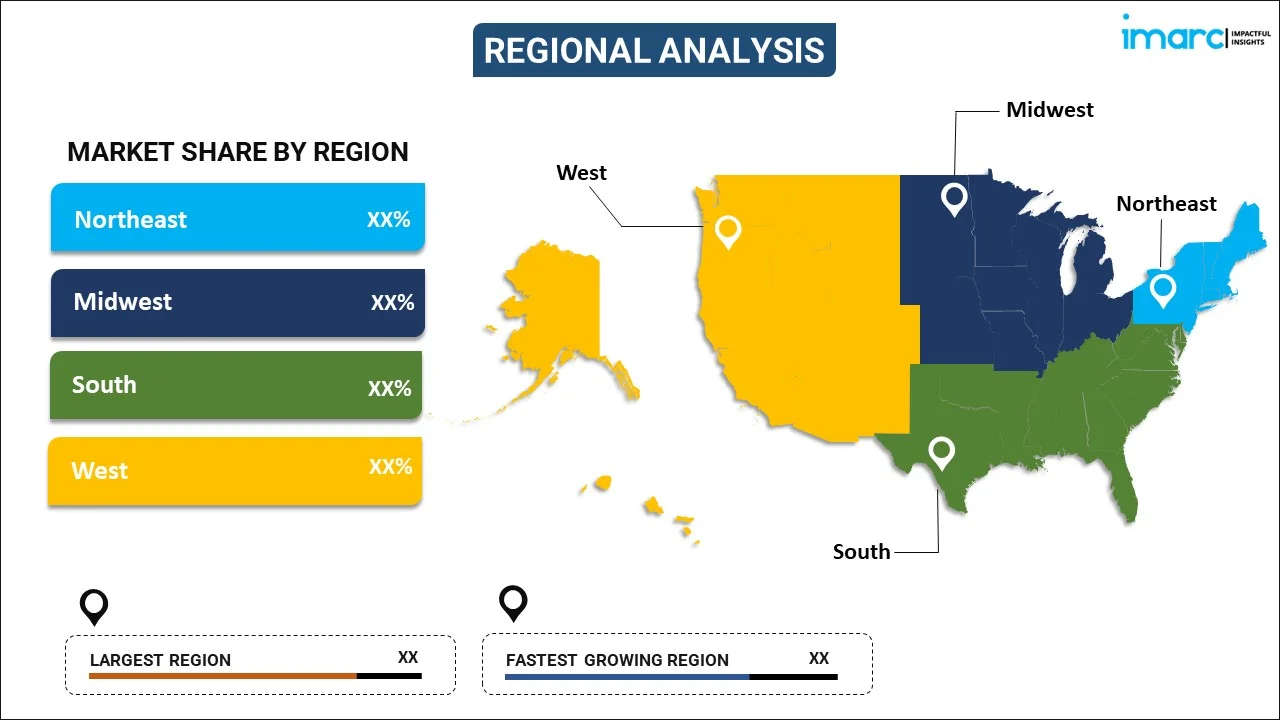
United States Chatbot Market Report by Type (Standalone, Web-based, Messenger-based/Third Party), Product (Artificial Intelligence, Marketing, Human Intelligence), Application (Bots for Service, Bots for Social Media, Bots for Payments/Order Processing, Bots for Marketing, and Others), Organization Size (Small Enterprises, Medium Enterprises, Large Enterprises), Vertical (Healthcare, Retail, Banking, Financial Services and Insurance, Media and Entertainment, Travel and Tourism, E-Commerce, and Others), and Region 2025-2033
Market Overview:
The United States chatbot market size reached USD 1.7 Million in 2024. Looking forward, IMARC Group expects the market to reach USD 10.5 Million by 2033, exhibiting a growth rate (CAGR) of 22.1% during 2025-2033. The continuous evolution of artificial intelligence and natural language processing technologies, the growing reliance on mobile and digital platforms, and the wide utilization of chatbots in healthcare represent some of the key factors driving the market.
|
Report Attribute
|
Key Statistics
|
|---|---|
|
Base Year
|
2024
|
|
Forecast Years
|
2025-2033
|
|
Historical Years
|
2019-2024
|
|
Market Size in 2024
|
USD 1.7 Million |
|
Market Forecast in 2033
|
USD 10.5 Million |
| Market Growth Rate 2025-2033 | 22.1% |
A chatbot refers to a sophisticated computer program designed to simulate human conversation through text or voice interactions. Leveraging artificial intelligence (AI) and natural language processing (NLP) technologies, chatbots are capable of understanding and interpreting user inputs and providing relevant responses in a conversational manner. These interactions can occur on various platforms, such as messaging apps, websites, and even voice-based assistants. Chatbots serve a wide range of purposes, from customer support and information retrieval to entertainment and task automation. They are trained on extensive datasets and algorithms that enable them to comprehend the nuances of language, including context, semantics, and user intent. Some chatbots follow pre-defined rules and scripted responses, while more advanced ones, often referred to as AI-powered chatbots, employ machine-learning techniques to improve their interactions over time.
United States Chatbot Market Trends:
The United States chatbot market is driven by a convergence of technological advancements, changing consumer preferences, and the pursuit of enhanced customer experiences across various industries. Moreover, the continuous evolution of artificial intelligence and natural language processing technologies also supports the market. These advancements have empowered chatbots to not only understand and respond to user inputs more accurately but also to engage in more nuanced and context-aware conversations. In the realm of customer service, businesses are increasingly adopting chatbots to provide immediate assistance to their customers. The 24/7 availability of chatbots ensures that customers can obtain quick resolutions to their queries, contributing to higher customer satisfaction levels. Additionally, the cost-effectiveness of chatbots compared to maintaining large customer support teams drives their adoption, particularly among startups and small to medium-sized enterprises. E-commerce is another sector where chatbots are making a significant impact. By analyzing user preferences and purchase history, chatbots can offer personalized product recommendations, thereby enhancing the shopping experience and driving sales. Furthermore, chatbots facilitate smoother transaction processes, aiding in order placements, payments, and even post-purchase support. The United States growing reliance on mobile and digital platforms is also fueling the chatbot market. As consumers spend more time on messaging apps and social media platforms, businesses see an opportunity to engage with them directly through chatbots. Brands use chatbots to deliver targeted marketing campaigns, disseminate information, and gather valuable consumer insights. This aligns with the shift toward conversational marketing, where the focus is on building meaningful interactions with customers rather than simply broadcasting messages. In sectors such as healthcare and finance, chatbots are playing a transformative role. In healthcare, they assist in appointment scheduling, symptom assessment, and medication reminders, thus improving patient engagement and healthcare accessibility. In finance, chatbots provide real-time account information, answer financial queries, and even aid in investment decisions.
United States Chatbot Market Segmentation:
IMARC Group provides an analysis of the key trends in each segment of the United States chatbot market report, along with forecasts at the country level for 2025-2033. Our report has categorized the market based on type, product, application, organization size, and vertical.
Type Insights:

- Standalone
- Web-based
- Messenger-based/Third party
The report has provided a detailed breakup and analysis of the market based on the type. This includes standalone, web-based, and messenger-based/third party.
Product Insights:
- Artificial Intelligence
- Marketing
- Human Intelligence
A detailed breakup and analysis of the United States chatbot market based on the product has also been provided in the report. This includes artificial intelligence, marketing, and human intelligence.
Application Insights:
- Bots for Service
- Bots for Social Media
- Bots for Payments/Order Processing
- Bots for Marketing
- Others
The report has provided a detailed breakup and analysis of the market based on the application. This includes bots for service, bots for social media, bots for payments/order processing, bots for marketing, and others.
Organization Size Insights:
- Small Enterprises
- Medium Enterprises
- Large Enterprises
A detailed breakup and analysis of the United States chatbot market based on the organization size has also been provided in the report. This includes small enterprises, medium enterprises, and large enterprises.
Vertical Insights:
- Healthcare
- Retail
- Banking, Financial Services, and Insurance
- Media and Entertainment
- Travel and Tourism
- E-Commerce
- Others
The report has provided a detailed breakup and analysis of the market based on the vertical. This includes healthcare, retail, banking, financial services and insurance, media and entertainment, travel and tourism, e-commerce, and others.
Regional Insights:

- Northeast
- Midwest
- South
- West
The report has also provided a comprehensive analysis of all the major regional markets, which include Northeast, Midwest, South, and West.
Competitive Landscape:
The report has also provided a comprehensive analysis of the competitive landscape in the market. Competitive analysis such as market structure, key player positioning, top winning strategies, competitive dashboard, and company evaluation quadrant has been covered in the report. Also, detailed profiles of all major companies have been provided.
United States Chatbot Market Report Coverage:
| Report Features | Details |
|---|---|
| Base Year of the Analysis | 2024 |
| Historical Period | 2019-2024 |
| Forecast Period | 2025-2033 |
| Units | Million USD |
| Scope of the Report | Exploration of Historical and Forecast Trends, Industry Catalysts and Challenges, Segment-Wise Historical and Predictive Market Assessment:
|
| Types Covered | Standalone, Web-based, Messenger-based/Third Party |
| Products Covered | Artificial Intelligence, Marketing, Human Intelligence |
| Applications Covered | Bots for Service, Bots for Social Media, Bots for Payments/Order Processing, Bots for Marketing, Others |
| Organization Sizes Covered | Small Enterprises, Medium Enterprises, Large Enterprises |
| Verticals Covered | Healthcare, Retail, Banking, Financial Services and Insurance, Media and Entertainment, Travel and Tourism, E-Commerce, Others |
| Regions Covered | Northeast, Midwest, South, West |
| Customization Scope | 10% Free Customization |
| Post-Sale Analyst Support | 10-12 Weeks |
| Delivery Format | PDF and Excel through Email (We can also provide the editable version of the report in PPT/Word format on special request) |
Key Questions Answered in This Report:
- How has the United States chatbot market performed so far and how will it perform in the coming years?
- What has been the impact of COVID-19 on the United States chatbot market?
- What is the breakup of the United States chatbot market on the basis of type?
- What is the breakup of the United States chatbot market on the basis of product?
- What is the breakup of the United States chatbot market on the basis of application?
- What is the breakup of the United States chatbot market on the basis of organization size?
- What is the breakup of the United States chatbot market on the basis of vertical?
- What are the various stages in the value chain of the United States chatbot market?
- What are the key driving factors and challenges in the United States chatbot market?
- What is the structure of the United States chatbot market and who are the key players?
- What is the degree of competition in the United States chatbot market?
Key Benefits for Stakeholders:
- IMARC’s report offers a comprehensive quantitative analysis of various market segments, historical and current market trends, market forecasts, and dynamics of the United States chatbot market from 2019-2033.
- The research study provides the latest information on the market drivers, challenges, and opportunities in the United States chatbot market.
- Porter's five forces analysis assist stakeholders in assessing the impact of new entrants, competitive rivalry, supplier power, buyer power, and the threat of substitution. It helps stakeholders to analyze the level of competition within the United States chatbot industry and its attractiveness.
- Competitive landscape allows stakeholders to understand their competitive environment and provides an insight into the current positions of key players in the market.
Need more help?
- Speak to our experienced analysts for insights on the current market scenarios.
- Include additional segments and countries to customize the report as per your requirement.
- Gain an unparalleled competitive advantage in your domain by understanding how to utilize the report and positively impacting your operations and revenue.
- For further assistance, please connect with our analysts.
 Inquire Before Buying
Inquire Before Buying
 Speak to an Analyst
Speak to an Analyst
 Request Brochure
Request Brochure
 Request Customization
Request Customization




.webp)




.webp)












